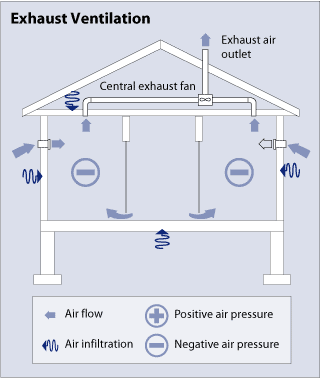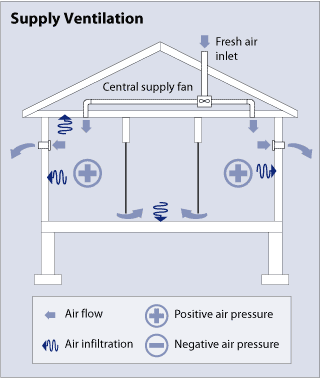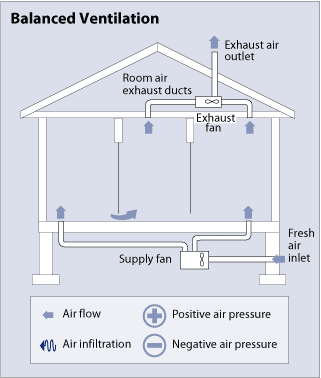How Do You Know When There Is Ciruclation Air in the House?
Energy-efficient homes -- both new and existing -- require mechanical ventilation to maintain indoor air quality. There are iv bones mechanical whole-house ventilation systems -- exhaust, supply, counterbalanced, and energy recovery.
Comparison of Whole-Firm Ventilation Systems
| Ventilation System | Pros | Cons |
| Frazzle |
|
|
| Supply |
|
|
| Balanced |
|
|
| Energy Recovery & Heat Recovery Ventilators |
|
|
Exhaust Ventilation Systems
Exhaust ventilation systems work by depressurizing your home. The system exhausts air from the house while make-up air infiltrates through leaks in the edifice vanquish and through intentional, passive vents.

Frazzle ventilation systems are about appropriate for cold climates. In climates with warm humid summers, depressurization can depict moist air into building wall cavities, where it may condense and cause moisture damage.
Frazzle ventilation systems are relatively simple and inexpensive to install. Typically, an exhaust ventilation system consists of a single fan connected to a centrally located, single frazzle indicate in the house. A better design is to connect the fan to ducts from several rooms, preferably rooms where pollutants are generated, such as bathrooms. Adjustable, passive vents through windows or walls tin be installed in other rooms to introduce fresh air rather than rely on leaks in the edifice envelope. Passive vents may, nonetheless, require larger pressure differences than those induced by the ventilation fan to work properly.
One business with exhaust ventilation systems is that -- along with fresh air -- they may draw in pollutants, including:
- Radon and molds from a crawlspace
- Dust from an cranium
- Fumes from an attached garage
- Flue gases from a fireplace or fossil-fuel-fired water heater and furnace.
These pollutants are a particular business when bath fans, range fans, and clothes dryers (which also depressurize the dwelling while they operate) are run when an exhaust ventilation arrangement is also operating.
Frazzle ventilation systems can also contribute to higher heating and cooling costs compared with energy recovery ventilation systems considering frazzle systems practice non temper or remove moisture from the make-upwardly air before it enters the house.
Supply Ventilation Systems
Supply ventilation systems utilize a fan to pressurize your home, forcing outside air into the edifice while air leaks out of the building through holes in the shell, bath, and range fan ducts, and intentional vents (if any exist).

Like exhaust ventilation systems, supply ventilation systems are relatively uncomplicated and inexpensive to install. A typical supply ventilation organization has a fan and duct system that introduces fresh air into usually ane -- only preferably several -- rooms that residents occupy nigh (due east.g., bedrooms, living room). This system may include adjustable window or wall vents in other rooms.
Supply ventilation systems allow better control of the air that enters the firm than frazzle ventilation systems do. By pressurizing the house, supply ventilation systems minimize outdoor pollutants in the living space and prevent backdrafting of combustion gases from fireplaces and appliances. Supply ventilation also allows outdoor air introduced into the business firm to be filtered to remove pollen and dust or dehumidified to provide humidity command
Supply ventilation systems work best in hot or mixed climates. Considering they pressurize the house, these systems have the potential to cause moisture problems in common cold climates. In wintertime, the supply ventilation organisation causes warm interior air to leak through random openings in the exterior wall and ceiling. If the interior air is humid plenty, wet may condense in the attic or cold outer parts of the exterior wall, resulting in mold, mildew, and disuse.
Like exhaust ventilation systems, supply ventilation systems practise not temper or remove moisture from the make-upwardly air before it enters the house. Thus, they may contribute to college heating and cooling costs compared with energy recovery ventilation systems. Considering air is introduced into the house at discrete locations, outdoor air may need to be mixed with indoor air before delivery to avert cold air drafts in the winter. An in-line duct heater is some other pick, but increases operating costs.
Balanced Ventilation Systems
Counterbalanced ventilation systems, if properly designed and installed, neither pressurize nor depressurize your domicile. Rather, they introduce and exhaust approximately equal quantities of fresh outside air and polluted within air.

A balanced ventilation organization usually has two fans and two duct systems. Fresh air supply and frazzle vents tin can be installed in every room, but a typical counterbalanced ventilation arrangement is designed to supply fresh air to bedrooms and living rooms where occupants spend the virtually time. Information technology likewise exhausts air from rooms where moisture and pollutants are most often generated (kitchen, bathrooms, and possibly the laundry room).
Some designs use a unmarried-signal exhaust. Because they directly supply outside air, balanced systems permit the use of filters to remove dust and pollen from outside air earlier introducing information technology into the business firm.
Counterbalanced ventilation systems are advisable for all climates. Because they require 2 duct and fan systems, still, balanced ventilation systems are unremarkably more expensive to install and operate than supply or exhaust systems.
Like both supply and frazzle systems, balanced ventilation systems do not atmosphere or remove moisture from the make-up air before it enters the house. Therefore, they may contribute to higher heating and cooling costs, dissimilar energy recovery ventilation systems. Also, like supply ventilation systems, outdoor air may need to exist mixed with indoor air earlier commitment to avert cold air drafts in the winter.
Energy Recovery Ventilation Systems
Energy recovery ventilation systems provide a controlled way of ventilating a dwelling while minimizing free energy loss. They reduce the costs of heating ventilated air in the winter by transferring estrus from the warm inside exhaust air to the fresh (but common cold) outside supply air. In the summertime, the inside air cools the warmer supply air to reduce cooling costs.
There are two types of energy-recovery systems: heat-recovery ventilators (HRV) and free energy-recovery (or enthalpy-recovery) ventilators (ERV). Both types include a rut exchanger, ane or more fans to button air through the car, and controls. There are some small-scale wall- or window-mounted models, but the majority are fundamental, whole-house ventilation systems with their own duct system or shared ductwork.
The primary divergence between a oestrus-recovery and an free energy-recovery ventilator is the way the oestrus exchanger works. With an free energy-recovery ventilator, the heat exchanger transfers a sure amount of water vapor along with rut energy, while a oestrus-recovery ventilator merely transfers heat.
Because an free energy-recovery ventilator transfers some of the moisture from the exhaust air to the usually less humid incoming winter air, the humidity of the business firm air stays more constant. This likewise keeps the heat exchanger core warmer, minimizing problems with freezing.
In the summer, an energy-recovery ventilator may help to command humidity in the house past transferring some of the water vapor in the incoming air to the theoretically drier air that's leaving the house. If y'all employ an air conditioner, an energy-recovery ventilator generally offers better humidity control than a estrus-recovery system. However, there's some controversy nearly using ventilation systems at all during humid, merely non overly hot, summer atmospheric condition. Some experts suggest that it is meliorate to turn the arrangement off in very humid conditions to go on indoor humidity levels low. You tin can likewise set up up the system so that information technology only runs when the air workout organisation is running, or use pre-cooling coils.
Most energy recovery ventilation systems can recover virtually seventy% to fourscore% of the energy in the exiting air and deliver that energy to the incoming air. However, they are most price-effective in climates with extreme winters or summers, and where fuel costs are loftier. In mild climates, the price of the additional electricity consumed past the arrangement fans may exceed the energy savings from not having to condition the supply air.
Free energy recovery ventilation systems usually cost more than to install than other ventilation systems. In full general, simplicity is key to a cost-effective installation. To relieve on installation costs, many systems share existing ductwork. Complex systems are not only more expensive to install, but they are generally more maintenance intensive and often consume more electric ability. For well-nigh houses, attempting to recover all of the free energy in the exhaust air will probably non be worth the additional cost. Also, these types of ventilation systems are still not very mutual. Just some HVAC contractors have plenty technical expertise and experience to install them.
In general, y'all desire to take a supply and return duct for each sleeping accommodation and for each common living area. Duct runs should be as short and straight equally possible. The correct size duct is necessary to minimize pressure drops in the system and thus improve performance. Insulate ducts located in unheated spaces, and seal all joints with duct mastic (never ordinary duct tape).
Also, energy recovery ventilation systems operated in common cold climates must accept devices to assistance prevent freezing and frost formation. Very cold supply air can cause frost germination in the heat exchanger, which can damage it. Frost buildup besides reduces ventilation effectiveness.
Free energy recovery ventilation systems require more than maintenance than other ventilation systems. They demand to be cleaned regularly to prevent deterioration of ventilation rates and rut recovery and to prevent mold and leaner on heat exchanger surfaces.
Source: https://www.energy.gov/energysaver/whole-house-ventilation
0 Response to "How Do You Know When There Is Ciruclation Air in the House?"
Post a Comment